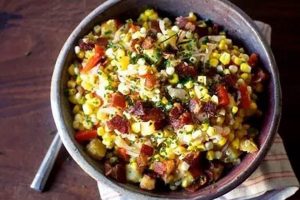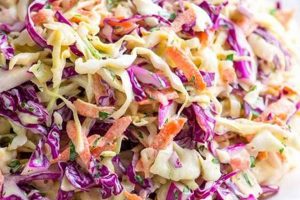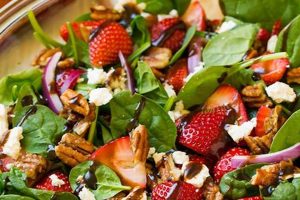A dish featuring thin, long noodles typically made from rice flour or wheat flour, combined with various ingredients like vegetables, herbs, proteins, and a flavorful dressing, constitutes this culinary creation. Examples include dishes with shrimp, shredded chicken, or tofu, often accompanied by fresh herbs like mint and cilantro, and vegetables such as carrots, cucumbers, and bean sprouts. The dressing can range from a light vinaigrette to a richer, nut-based sauce.
This type of dish offers a refreshing and versatile meal option, adaptable to diverse dietary needs and preferences. Its popularity stems from the ease of preparation, the ability to incorporate seasonal ingredients, and the balance of flavors and textures. Historically, noodle dishes have played a significant role in various Asian cuisines, showcasing regional variations and culinary traditions. The adaptability of noodles allows for a wide range of interpretations, contributing to the global appeal of these dishes.
Further exploration will delve into specific variations, regional adaptations, and tips for preparation, offering a deeper understanding of the culinary possibilities this dish presents.
Tips for Preparing a Delicious Vermicelli Noodle Salad
Achieving optimal results requires attention to key details throughout the preparation process. The following tips offer guidance for creating a flavorful and satisfying dish.
Tip 1: Noodle Selection and Preparation: Choosing the correct noodle type is crucial. Rice vermicelli is traditional, but other thin noodles like bean thread or cellophane noodles can be substituted. Follow package instructions for cooking, ensuring noodles are cooked al dente, rinsed with cold water, and drained thoroughly to prevent stickiness.
Tip 2: Vegetable Preparation: Fresh, crisp vegetables are essential. Julienne or thinly slice vegetables like carrots, cucumbers, and bell peppers for optimal texture and aesthetic appeal. Consider blanching or quickly sauting harder vegetables like green beans or broccoli before adding them to the salad.
Tip 3: Protein Choices: Versatile protein options include cooked shrimp, shredded chicken, grilled tofu, or thinly sliced beef. Ensure proteins are cooked thoroughly and cooled before adding them to the salad.
Tip 4: Herb and Aromatic Incorporation: Fresh herbs such as mint, cilantro, basil, and Thai basil contribute significantly to the flavor profile. Incorporate finely chopped herbs generously. Consider adding aromatics like finely minced garlic, ginger, or shallots for enhanced complexity.
Tip 5: Dressing Preparation: The dressing balances and unifies the flavors. A classic vinaigrette, a vibrant peanut sauce, or a tangy lime dressing are popular choices. Adjust the dressing’s sweetness, acidity, and spiciness to complement the other ingredients.
Tip 6: Assembly and Serving: Combine all ingredients gently, ensuring even distribution of the dressing. Serve immediately for the best flavor and texture. Garnish with chopped nuts, sesame seeds, or fried shallots for added visual appeal and crunch.
Tip 7: Timing and Storage: Prepare the noodles, vegetables, and protein components in advance. Combine the ingredients and add the dressing just before serving to prevent the salad from becoming soggy. While storage is possible, it’s recommended to consume the salad fresh for optimal quality.
By following these tips, one can achieve a well-balanced, flavorful, and visually appealing noodle salad. The combination of textures, flavors, and fresh ingredients contributes to a satisfying culinary experience.
The following section will offer specific recipe examples demonstrating these principles in practice.
1. Noodles (type, cooking)
Noodle selection and preparation are fundamental to a successful vermicelli salad recipe. The type of noodle influences the dish’s texture and ability to absorb flavors, while proper cooking ensures the desired consistency and prevents a gummy or mushy outcome. This section explores the critical aspects of noodle choice and preparation techniques.
- Type:
While “vermicelli” typically refers to thin noodles made from rice flour, variations exist, including those made from wheat, mung bean, or potato starch. Rice vermicelli offers a delicate texture and neutral flavor, readily absorbing the dressing and other ingredients’ flavors. Wheat-based vermicelli provides a slightly chewier texture, while bean thread noodles offer a translucent appearance and slippery texture. Choosing the appropriate noodle type depends on the desired outcome and regional variations of the salad.
- Cooking Method:
Proper cooking is crucial for achieving the desired texture. Most dried vermicelli noodles require brief boiling or soaking in hot water. Overcooking results in a mushy texture, while undercooking leads to a stiff, unpleasant mouthfeel. Following package instructions is essential, as cooking times vary depending on the noodle type and thickness. Rinsing the cooked noodles under cold water stops the cooking process and removes excess starch, preventing sticking.
- Fresh vs. Dried Noodles:
Fresh rice noodles, often found in refrigerated sections of Asian markets, offer a softer texture and require shorter cooking times than dried noodles. Dried noodles, however, offer greater convenience and longer shelf life. The choice depends on availability and personal preference. Regardless of the type, achieving the correct texture through proper cooking techniques is paramount.
- Impact on the Final Dish:
The noodle’s texture significantly impacts the overall enjoyment of the salad. A properly cooked noodle provides a pleasant chewiness, contrasting with the crispness of the vegetables and other ingredients. The noodle’s ability to absorb the dressing’s flavors is also crucial, ensuring a well-balanced and flavorful dish. A gummy or mushy noodle detracts from the experience, highlighting the importance of careful noodle selection and preparation.
The interplay between noodle type and cooking method directly influences the final dish’s success. Mastering these aspects ensures a vermicelli salad with optimal texture, flavor absorption, and overall appeal, contributing to a delightful culinary experience.
2. Vegetables (fresh, crisp)
The incorporation of fresh, crisp vegetables is paramount in a vermicelli salad recipe. These elements contribute not only vital nutrients but also textural contrast and visual appeal, elevating the dish from simple sustenance to a vibrant culinary experience. Their selection and preparation significantly influence the final product’s overall quality and enjoyment.
- Variety and Selection:
A diverse array of vegetables enhances both the nutritional value and the sensory experience. Common choices include shredded carrots, julienned cucumbers, sliced bell peppers, bean sprouts, and shredded lettuce. Seasonal variations offer opportunities for creativity, incorporating ingredients like shredded jicama, blanched asparagus, or thinly sliced radishes. The selection should consider color, texture, and flavor profiles, ensuring a balanced and appealing composition.
- Preparation Techniques:
Proper preparation techniques maintain the vegetables’ crispness and freshness. Washing and drying thoroughly are essential. Cutting vegetables into uniform shapes and sizes ensures even cooking and distribution throughout the salad. Some vegetables, like carrots or green beans, may benefit from quick blanching or stir-frying to enhance their tenderness while retaining their crunch. Avoiding over-preparation is crucial to prevent wilting or sogginess.
- Flavor and Texture Contribution:
The vegetables’ inherent flavors and textures contribute significantly to the salad’s overall complexity. The sweetness of carrots, the refreshing coolness of cucumbers, and the peppery notes of radishes create a dynamic interplay. The contrast between the soft noodles and the crisp vegetables adds a textural dimension that enhances the eating experience. Careful consideration of these elements ensures a well-balanced and satisfying dish.
- Nutritional Value and Health Benefits:
Incorporating a variety of fresh vegetables elevates the nutritional profile of the vermicelli salad. These ingredients contribute essential vitamins, minerals, and dietary fiber, promoting overall health and well-being. The emphasis on fresh, minimally processed vegetables aligns with healthy eating principles, making the salad a nutritious and flavorful meal option.
The strategic selection and meticulous preparation of fresh, crisp vegetables are integral to a successful vermicelli salad. These components contribute not only visual appeal and textural contrast but also nutritional value and a complex flavor profile. Their presence elevates the dish from a basic noodle salad to a vibrant and healthful culinary creation.
3. Protein (optional, varied)
Protein, while optional, plays a significant role in augmenting the nutritional value and culinary depth of a vermicelli salad recipe. Its inclusion transforms the dish from a light accompaniment to a more substantial and satisfying meal. The versatility of protein choices allows for customization based on dietary preferences, cultural influences, and desired flavor profiles.
- Types of Protein:
The selection of protein significantly influences the overall character of the salad. Common choices include cooked shrimp, shredded chicken, grilled tofu, thinly sliced beef, or pan-fried fish. Each protein offers a unique flavor profile and textural contribution, ranging from the delicate sweetness of shrimp to the robust earthiness of tofu. The choice depends on the desired outcome and complements the other ingredients.
- Preparation Methods:
The preparation method impacts both the flavor and texture of the protein. Grilling imparts a smoky char, while pan-frying creates a crispy exterior. Boiling or steaming offers a gentler approach, preserving the protein’s natural moisture. Marinating the protein before cooking can infuse additional flavors and tenderize the texture. The chosen method should align with the desired outcome and the overall flavor profile of the salad.
- Nutritional Considerations:
The addition of protein elevates the nutritional value of the salad, providing essential amino acids crucial for muscle building and repair. Lean protein sources, such as chicken breast or fish, contribute to a healthier meal option. Plant-based proteins, like tofu or tempeh, offer a vegetarian or vegan alternative while still providing substantial protein content. The choice of protein can be tailored to specific dietary needs and preferences.
- Impact on Flavor and Texture:
Protein contributes not only nutritional value but also depth of flavor and textural complexity. The savory notes of meat or the subtle nuances of tofu interact with the other ingredients, creating a more layered and satisfying culinary experience. The protein’s texture, whether tender, flaky, or chewy, contrasts with the soft noodles and crisp vegetables, adding another dimension to the sensory experience.
The inclusion of protein in a vermicelli salad recipe elevates the dish from a simple side to a complete and satisfying meal. Careful consideration of protein type, preparation method, and its impact on the overall flavor and nutritional profile allows for customization and enhances the culinary experience. This versatility makes protein a valuable component in creating a well-balanced and flavorful vermicelli salad.
4. Dressing (flavorful, balanced)
The dressing serves as the unifying element in a vermicelli salad recipe, binding the diverse ingredients and imparting a cohesive flavor profile. A well-crafted dressing elevates the dish beyond a simple assembly of components, transforming it into a harmonious culinary creation. Its balance of flavors, textures, and aromatic complexity is crucial for a successful and satisfying outcome.
- Flavor Profiles:
The dressing’s flavor profile dictates the overall character of the salad. Options range from tangy and vibrant to rich and savory. A classic vinaigrette, with its bright acidity and subtle sweetness, provides a refreshing counterpoint to the other ingredients. A creamy peanut sauce offers a richer, nuttier dimension, while a fish sauce-based dressing contributes umami notes and a savory depth. The chosen flavor profile should complement the other ingredients, creating a balanced and harmonious composition.
- Balance of Sweet, Sour, Salty, and Spicy:
Achieving a harmonious balance of fundamental tastes is essential for a successful dressing. The interplay of sweet, sour, salty, and spicy elements creates a dynamic and engaging flavor profile. The sweetness can derive from sugar, honey, or fruit juices, while acidity comes from vinegar, lime juice, or tamarind paste. Salt enhances the other flavors, and chili peppers or other spices introduce heat. The precise balance of these elements depends on the desired outcome and the other ingredients’ characteristics.
- Texture and Viscosity:
The dressing’s texture and viscosity contribute to the overall sensory experience. A thin, vinaigrette-style dressing lightly coats the noodles and vegetables, allowing their individual flavors to shine. A thicker, creamier dressing clings more readily, providing a richer mouthfeel and a more substantial presence. The desired texture influences the choice of ingredients and preparation methods. Emulsified dressings, like mayonnaise-based or peanut-based options, offer a smooth and creamy texture.
- Aromatic Complexity:
Aromatic ingredients enhance the dressing’s complexity and depth of flavor. Fresh herbs, such as mint, cilantro, or basil, contribute vibrant herbaceous notes. Garlic, ginger, and shallots add pungent and savory dimensions. Toasted sesame oil provides a nutty aroma, while fish sauce introduces umami notes. The strategic use of these aromatics elevates the dressing beyond a simple flavoring agent, transforming it into a key component of the dish’s overall character.
The dressing in a vermicelli salad recipe is more than just a condiment; it’s the conductor of the culinary orchestra. It harmonizes the diverse flavors, textures, and aromas of the ingredients, creating a cohesive and satisfying culinary experience. The careful consideration of flavor profiles, balance, texture, and aromatic complexity is essential for achieving a truly exceptional vermicelli salad. A well-crafted dressing elevates the dish, transforming it from a simple combination of ingredients into a complex and delightful culinary creation.
5. Herbs/Aromatics (fresh, vibrant)
Fresh herbs and aromatics constitute essential components of a successful vermicelli salad recipe, contributing significantly to its vibrancy, complexity, and overall sensory appeal. Their strategic incorporation elevates the dish beyond a simple combination of ingredients, infusing it with layers of flavor and aromatic depth. Careful selection and application of these elements are crucial for achieving a balanced and harmonious culinary experience.
- Flavor Enhancement:
Fresh herbs impart distinctive flavor profiles that complement and enhance the other ingredients. Mint provides a cooling, refreshing note, while cilantro contributes a bright, citrusy zest. Thai basil offers a subtle anise-like flavor, and traditional basil lends a sweet, peppery aroma. These herbaceous notes interact with the other components, creating a complex and nuanced flavor profile. The selection of herbs should consider the overall flavor profile desired for the salad.
- Aromatic Complexity:
Aromatics, such as garlic, ginger, shallots, and chilies, contribute pungent and complex aromas that elevate the sensory experience. Garlic offers a sharp, savory note, while ginger provides a warm, spicy kick. Shallots contribute a subtle sweetness, and chilies introduce varying levels of heat. These aromatic elements add depth and complexity to the salad, engaging multiple senses and creating a more immersive culinary experience.
- Visual Appeal and Freshness:
The vibrant green hues of fresh herbs enhance the visual appeal of the vermicelli salad, adding a touch of freshness and vibrancy. Their incorporation not only contributes flavor and aroma but also elevates the aesthetic presentation of the dish. The visual contrast between the herbs, noodles, and other ingredients creates a more appealing and appetizing presentation.
- Cultural Significance and Regional Variations:
The specific herbs and aromatics used often reflect regional culinary traditions and cultural influences. Southeast Asian vermicelli salads frequently feature mint, cilantro, and Thai basil, while Vietnamese variations may incorporate fish mint or culantro. These regional variations highlight the diverse applications of herbs and aromatics in creating unique and authentic flavor profiles.
The interplay of fresh herbs and aromatics is integral to a well-executed vermicelli salad recipe. Their combined contribution of flavor, aroma, visual appeal, and cultural significance elevates the dish from a simple combination of ingredients to a complex and nuanced culinary creation. Careful consideration of these elements ensures a balanced and harmonious sensory experience, showcasing the essential role of herbs and aromatics in achieving a truly exceptional vermicelli salad.
Frequently Asked Questions
This section addresses common inquiries regarding vermicelli noodle salad preparation, offering clarity and guidance for achieving optimal results.
Question 1: What is the best type of vermicelli noodle to use?
While rice vermicelli is traditional, thin noodles made from mung bean, potato starch, or even wheat can be substituted depending on dietary preferences and desired texture. Rice vermicelli offers a neutral flavor and delicate texture.
Question 2: Can vermicelli salad be prepared in advance?
While components like noodles, vegetables, and protein can be prepared separately ahead of time, it’s recommended to combine and dress the salad just before serving to prevent the noodles from becoming soggy and the vegetables from wilting.
Question 3: How long can vermicelli salad be stored?
Storage is possible, but it’s best consumed fresh. If storing, keep the noodles, vegetables, protein, and dressing separate and combine just before serving. Refrigerate components for a maximum of two days.
Question 4: What are common substitutions for ingredients?
Ingredient flexibility allows for customization. Tofu can replace shrimp or meat for vegetarian options. Various vegetables can be substituted based on seasonal availability and preference. Different herbs and spices can be incorporated to adjust the flavor profile.
Question 5: How can one prevent the noodles from sticking together?
Rinsing the cooked noodles thoroughly under cold water removes excess starch and stops the cooking process, minimizing stickiness. Tossing the noodles lightly with a small amount of oil can further prevent clumping.
Question 6: How can the spiciness level be adjusted?
Spiciness is easily adjusted by varying the amount of chili added to the dressing. Fresh chilies, chili flakes, or chili garlic sauce can be used. Start with a small amount and adjust to taste.
Understanding these key aspects of vermicelli salad preparation ensures a successful and satisfying culinary outcome. Addressing these common concerns enables a more informed approach, allowing for greater confidence and enjoyment in creating this versatile and flavorful dish.
The next section will provide a collection of varied and delicious vermicelli salad recipes.
Vermicelli Salad Recipe
Exploration of the multifaceted nature of vermicelli salad recipes has revealed key components contributing to a successful dish. From noodle selection and preparation to the incorporation of fresh vegetables, proteins, flavorful dressings, and aromatic herbs, each element plays a crucial role in the final product. An understanding of these components allows for informed choices, enabling customization and adaptation to individual preferences and dietary needs. Emphasis on fresh, high-quality ingredients, proper cooking techniques, and balanced flavor profiles ensures a satisfying and nutritious culinary experience. Regional variations and cultural influences further enrich the possibilities, highlighting the versatility and adaptability of this dish.
The potential for creative exploration within the realm of vermicelli salad recipes remains vast. Continued experimentation with diverse ingredients, flavor combinations, and cultural adaptations promises further evolution and refinement of this culinary staple. Culinary enthusiasts are encouraged to embrace the versatility offered by vermicelli salad recipes, exploring the myriad possibilities and contributing to the ongoing evolution of this vibrant and adaptable dish.






